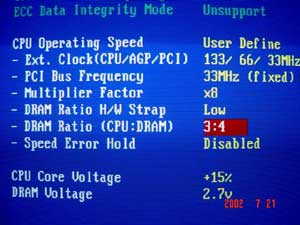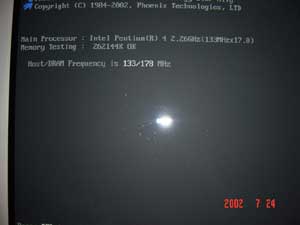|
|
Advertisement:
|
|
Abit BD7-II RAID (i845E P4) Motherboard |
|
Join the community - in the OCAU Forums!
|
Installation, BIOS, How We Tested
Installation:
Our test BD7-II was up and running without any hiccup. As we changed the test HDD from an AMD/VIA system, we reinstalled the OS in the process to avoid any conflict. We checked the Intel download area and found that the ABIT provided drivers are outdated. We grabbed the new ones, and installed them without any problem. So far, so good.
BIOS:
In the BIOS area the BD7-II starts distinguishing itself from the crowd: ABIT is well known for their highly tweakable BIOS. Those who are longer in the business remember that it was ABIT, which introduced the jumper- less board design and a made history with their SOFTMENUE BIOS tweaking options. The BD7-II Award BIOS has all the usual options and functions, there is nothing much to mention about it. What attracted immediately our interest were some very specific SOFTMENU options in the first section of the BD7-II BIOS. Here you go: - FSB frequency setting in 1 MHz increments up to 200 MHz
- CPU:RAM ratio selectable at 4:3, 1:1, and to 3:4.
- Fixed PCI frequencies at 33 MHz, 37 MHz, and 44 MHz
- CPU voltage: default, + 5%, +10%, +15%
- DIMM voltage: 2.5 volt (default), 2.6 volt, 2.6 volt

These options make the BD7-II BIOS an overclocker’s orchard. Setting the CPU:Memory ratio to 3:4, puts the FSB at 133 MHz and the RAM frequency at 177 MHz. That means: without overclocking the CPU and compromising stability it is possible to attain superb bandwidth, provided of course quality DDR RAM is at hand. More about this later. And even better: the 3:4 gives enormous leverage when the FSB frequency is increased, because then the RAM frequency goes up accordingly in a 3:4 ratio. God-sent is also the capability to fix the PCI/AGP frequency. This keeps PCI devices running at their stock frequency or intentionally slightly overclocked, just as the user wishes. With the PCI frequency fixed nobody needs to worry anymore about the dreaded “inaccessible boot device” or a black monitor screen, because the HDD and the video card are succumbing to out-of-specification CPU front-side-bus frequencies.
How We Tested:
Test Setting:
CPU - P4 Northwood “B” 2.26 GHz
Heatsink and Fan - Intel stock HSF (Sanyo Denki 2,200 rpm) -or- Vapochill evaporator
Memory - 256 MB generic Samsung PC 2700/TBC3
Case - LIAN LI PC-70 -or- Vapochill
Monitor - 22-inch Mitsubishi RDF22P
PSU - 520 Watt Torica
HDD - 40 GB Maxtor D740X ATA 133
OS - Windows 2000 Professional SP 2
Video - GF3 Hercules Prophet TI500
Peripherals - Kenwood 72x / Pioneer DVD 116
Chipset and Video Driver - Intel 4.00.1013, Detonator 29.42
Test Software 1: Subsystem Testing with synthetic benchmarks - PC Mark 2002, Sandra 2002 Professional SP 1, 3Dmark 2001 SE
Test Software 2: Overall System Performance tested with aplications - Content Creation 2002, Business Winstone 2001
Officially, meaning according to the Intel 845E chipset specification and the BD7-II specification sheet, such an 845E chipset based board should be used either with PC1600 (2 x 100 MHz) or PC2100 (2 x 133 MHz). The BD7-II user however does not have to care about these “indications”. As already mentioned: the BD7-II BIOS offers the option to run the CPU and the memory asynchronous with a 3:4 ratio. When the 3:4 BIOS option is enabled the CPU runs at 133 MHz and the memory at 177 MHz. In this case the RAM is even working at a higher frequency than PC2700/DDR333 (2 x 166 MHz). At stock settings, the 3:4 ratio enabled, we have the following situation:- CPU frequency: 133 MHz x 17 = 2260 MHz
- Memory frequency: 177 MHz x 2 = 354 MHz

We run our first benchmarking round with these, non-overclocked stock settings to get a starting line for the following overclocking attempts. The table below also shows results with a Thoroughbred 2200+ running the same tests at our reference KT333 board, the A7V333. Although AMD is obviously aiming with the Thoroughbred 2200+ at the same performance level as the P4 2.26, we can see that the AMD CPU on a KT333 chipset based board is in all tests quite a few points behind. And then of course, a Thoroughbred 2200+ can be overclocked just 350 or 400 MHz, whereas a P4 2.26 offers almost 700 to 800 MHz on top when running on a 845E chipset board like the BD7-II, as we will show later. We don’t want to join here the ”AMD/Intel: Who is better?” discussion. But looking at our results it is understandable that currently many AMD users are considering a move.
We found that the BD7-II is slightly undervolting on basically all rails. The CPU voltage, the 12-volt line, the 5-volt line and various other voltage readings were all slightly below their defaults. Many users have already observed and reported this phenomenon with their BD7-II. We don’t know whether this is really an issue, because it seems without any impact on stability or overclocking capability. Maybe it’s only a BIOS misreading. ABIT should look into this; probably a BIOS revision can correct it.
|
|
Advertisement:
All original content copyright James Rolfe.
All rights reserved. No reproduction allowed without written permission.
Interested in advertising on OCAU? Contact us for info.
|

|


